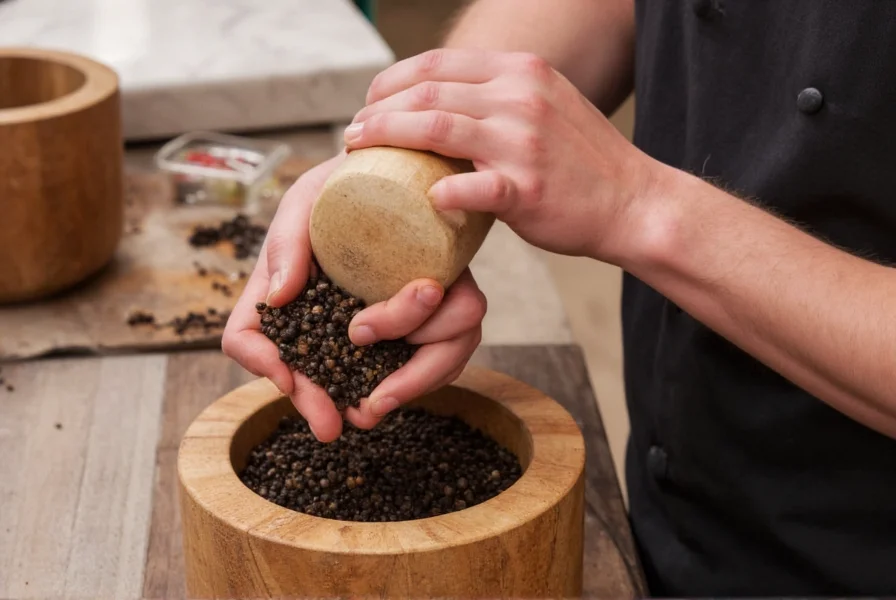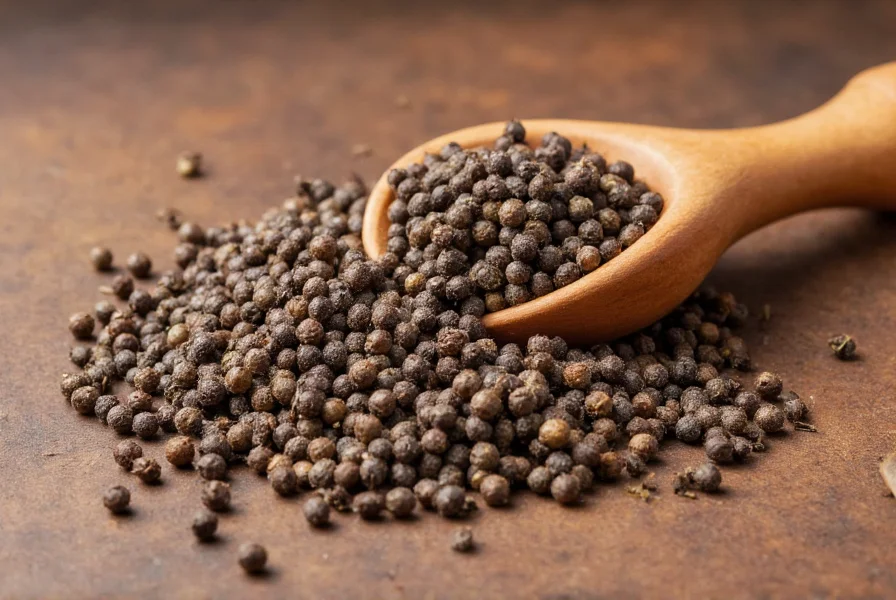Understanding the unique properties of coarse ground pepper transforms ordinary dishes into culinary experiences with layered heat and texture. Unlike fine pepper that disperses quickly, coarse grind maintains structural integrity during cooking, releasing piperine—the compound responsible for pepper's heat—more gradually for balanced flavor development.
What Defines Coarse Ground Pepper?
Coarse ground pepper features distinct granules measuring approximately 1-2 millimeters in diameter, creating visible specks that provide both textural contrast and controlled flavor release. This grind sits between whole peppercorns and medium grind on the particle size spectrum:
| Grind Type | Particle Size | Best Applications |
|---|---|---|
| Whole peppercorns | 4-6mm | Pickling, slow-cooked dishes |
| Coarse ground | 1-2mm | Meat rubs, marinades, finishing |
| Medium ground | 0.5-1mm | General cooking, sauces |
| Fine ground | <0.5mm | Dusting finished dishes, delicate sauces |
The larger surface area-to-volume ratio in coarse grind creates a different interaction with food compared to finer versions. When applied to meats before cooking, these substantial particles create a flavorful crust while allowing heat to penetrate gradually, preventing the bitter notes that can emerge from overcooked fine pepper.
Flavor Dynamics of Coarse Ground Pepper
Chemical analysis reveals why coarse grind delivers superior flavor performance in specific applications. The slower dissolution rate means piperine—the active compound in black pepper—releases over an extended period rather than all at once. This gradual release prevents the sharp, sometimes bitter notes that can occur when fine pepper burns during high-heat cooking.
Professional chefs prefer coarse ground pepper for steak preparation because the larger particles:
- Create visual appeal with visible specks on the surface
- Form a flavorful crust without burning
- Provide textural contrast against tender meat
- Release heat gradually during consumption

Optimal Culinary Applications
Certain cooking techniques particularly benefit from coarse ground pepper's unique properties. The "when to use coarse ground pepper" decision depends on both the cooking method and desired sensory outcome.
Meat Preparation Techniques
For dry rubs on thick-cut steaks or roasts, coarse ground pepper outperforms finer grinds by:
- Maintaining structural integrity during searing
- Creating a flavorful crust without burning
- Providing textural interest in the finished dish
When making compound butter, coarse grind adds pleasant texture pockets that melt gradually, creating flavor bursts rather than uniform distribution.
Marinade Formulation
In acidic marinades, coarse ground pepper's slower dissolution prevents premature flavor release. The particles penetrate meat surfaces gradually during the marinating process, creating deeper flavor penetration than fine pepper which might lose potency before cooking.
Storage Considerations for Coarse Ground Pepper
Due to increased surface area, coarse ground pepper loses potency faster than whole peppercorns but maintains freshness longer than fine ground versions. Proper storage extends shelf life significantly:
- Air-tight containers preserve volatile oils 30% longer than open containers
- Cool, dark locations prevent UV degradation of piperine compounds
- Refrigeration extends peak flavor period by 2-3 months
Unlike fine pepper that can clump when exposed to moisture, coarse grind maintains flowability longer due to reduced surface area contact between particles—a practical advantage for consistent seasoning.
Creating Perfect Coarse Ground Pepper at Home
For optimal coarse ground pepper, follow these professional techniques:
- Select high-quality whole peppercorns (Tellicherry or Lampong varieties offer superior flavor complexity)
- Use a mortar and pestle with controlled pressure for consistent 1-2mm particles
- Grind in small batches to maintain temperature control (heat degrades volatile compounds)
- Store immediately in air-tight containers away from light

Electric grinders often produce inconsistent results for coarse grind. If using an electric mill, select the widest setting and pulse rather than continuous grinding to prevent overheating. The ideal coarse grind should resemble coarse sea salt in appearance—distinct, separate granules rather than a fine powder.
Common Usage Mistakes to Avoid
Even experienced cooks sometimes misuse coarse ground pepper. Avoid these common errors:
- Adding too early in cooking: For sauces and soups, add coarse pepper during the last 5-7 minutes of cooking to preserve volatile flavor compounds
- Using in delicate dishes: Avoid coarse grind in light-colored sauces or custards where visible particles create undesirable texture
- Incorrect storage: Never store near heat sources like stovetops—temperature fluctuations accelerate flavor degradation
- Over-grinding: When using pre-ground, check particle size—many "coarse" commercial products are actually medium grind
When Coarse Ground Pepper Shines
Certain dishes particularly benefit from coarse ground pepper's distinctive properties. Understanding "what dishes use coarse ground pepper" helps maximize culinary results:
- Steak preparation: Creates flavorful crust on ribeyes and strip steaks
- Homemade sausages: Provides textural interest and slow heat release
- Roasted vegetables: Adheres better to vegetable surfaces than fine grind
- Artisan breads: Adds visual appeal and flavor pockets in seeded breads
The distinctive visual appeal of coarse ground pepper makes it ideal for finishing dishes where presentation matters. Unlike fine pepper that disappears into food, coarse grind creates attractive speckling that signals flavor intensity to diners before the first bite.
Frequently Asked Questions
Can I substitute coarse ground pepper for regular pepper in recipes?
Yes, but with adjustments. Use 25% less coarse ground pepper than fine grind since its slower dissolution means less immediate heat. For baking or delicate sauces where texture matters, substitute with freshly cracked medium grind instead.
Why does coarse ground pepper taste different from fine ground?
The larger particle size creates a slower release of piperine (pepper's active compound), resulting in more gradual heat development and reduced bitterness. Scientific analysis shows coarse grind maintains optimal flavor compounds 30-40% longer during cooking compared to fine grind.
How can I tell if my coarse ground pepper has gone bad?
Fresh coarse ground pepper should have a sharp, piney aroma and vibrant heat. Signs of degradation include faded aroma, diminished heat sensation, and visible moisture clumping. Properly stored, coarse grind maintains peak quality for 4-6 months—significantly longer than fine grind but shorter than whole peppercorns.
What's the best way to grind pepper for coarse consistency at home?
Use a mortar and pestle with controlled pressure for most consistent results. Alternatively, set your pepper mill to the widest setting and use short pulses rather than continuous grinding. The ideal coarse grind resembles coarse sea salt—distinct, separate granules approximately 1-2mm in diameter that don't flow like fine powder.
Why do professional chefs prefer coarse ground pepper for steak?
Coarse ground pepper creates a flavorful crust during searing without burning, provides visual appeal with visible specks, and releases heat gradually during consumption. The larger particles maintain structural integrity at high temperatures where fine pepper would burn and develop bitter notes, resulting in more balanced flavor development.











 浙公网安备
33010002000092号
浙公网安备
33010002000092号 浙B2-20120091-4
浙B2-20120091-4